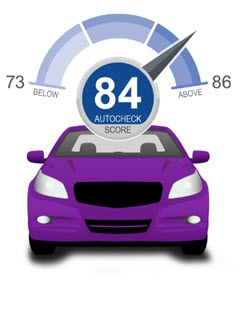Introducing the newly designed AutoCheck Score™
 Quickly compare and select used vehicles
Quickly compare and select used vehicles
As an auto industry professional, you use vehicle history reports every day. But they’re long, complex — easily misinterpreted. You always aim to conduct a thorough inspection. But what if you’re at a busy auction house or browsing online, where there’s simply not enough time or context?
The tool you use every day to make critical decisions about used vehicles should be accurate and easy to understand — built for streamlined evaluation. So we made one.
New look, same impact
We’ve revamped the AutoCheck score with a modern look and feel that’s easier than ever to read. And it’s still invaluable for quickly comparing and selecting used vehicles. What, exactly, is it? Experian® analyzes the detailed records in an AutoCheck® vehicle history report to generate the AutoCheck Score.
Like a credit score or gas mileage rating for new vehicles, it’s a single number on a standardized scale. The new gauge shows the score range (from 1 – 100) for vehicles of similar age in the same class. If a car is above average in its range, you can feel confident that it’s a solid investment.
The score makes it much simpler to assess how a used vehicle measures up, estimating its:
- Overall roadworthiness
- Reliability compared to other vehicles in its class
- Likelihood of being on the road in five years
It is invaluable for making informed decisions, managing inventory, mitigating risk and instilling confidence in customers.
Bigger, better
You can depend on the AutoCheck Score to deliver a high-quality, more accurate assessment. That’s because it’s derived from Experian’s world-class, continually updated database, which leverages reliable information from extensive sources, including:
- Tens of thousands of distinct accident sources, many exclusive to Experian
- 95% of U.S. auction houses — most providing structural damage, salvage-and-junk and export-data announcements exclusively to Experian
- Important OEM safety and open recall data
- State departments of motor vehicles and departments of public safety, insurance companies and other independent sources
- Police department/state agency accident information from all 50 states and Washington D.C.
- Federal sources, like import records
That’s a lot of data. And some complex statistical modeling. Don’t worry; we’ll take care of the heavy lifting. All you have to do is keep score.
Why you need it
Whether you’re a dealer, lender, manufacturer certified pre-owned program or consumer portal, the score will transform the way you do business to boost your bottom line.
Dealers: Use the score to mitigate risk, manage and market your inventory, close sales faster and build customer loyalty.
Lenders/Credit Unions: Use the score to more accurately estimate a vehicle’s value at every stage of the loan life cycle, from origination to portfolio review, account management and asset collection.
Manufacturer Certified Pre-Owned Programs: Use the AutoCheck report for vehicle certification.
Consumer Portals: Increase customer satisfaction — and traffic — by allowing OEMs and dealers to post the score with their listings and make online car shopping a breeze.
Count on the AutoCheck Score
To learn more about the score — or how to wield its power to maximal effect — find its secrets in this treasure trove of a white paper or call 1 888 675 5596.
What are you waiting for? Redesign your business with the redesigned score.


